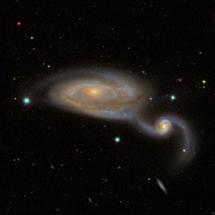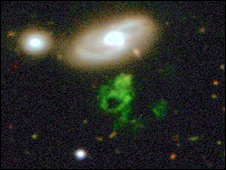As we pointed out in our March/April 08 issue, astronomy is one of the few fields of science in which amateurs can make a substantial contribution. There's no better illustration of that than Galaxy Zoo, a spinoff of the Sloan Digital Sky Survey that allows anyone with a computer to help classify galaxies spotted by the survey.
During the last 18 months, more than 150,000 people submitted 80 million classifications of one million objects, according to a press release from the University of Oxford (their astronomers lead the Galaxy Zoo effort, which involves six other universities in the US and UK as well as Adler Planetarium in Chicago.)
The volunteers sorted the galaxies by type--spiral or elliptical--and by which way they were rotating. They discovered 3,000 pairs of merging galaxies and a very weird, one-of-a-kind green blob called Hanny's Voorwerp (voorwerp means "object" in Dutch) after schoolteacher Hanny Van Arkel, who found it. The blob was later partially explained as the result of a jet of energetic particles from a black hole.
Now the Zoo keepers have launched Galaxy Zoo 2, which will focus on the 250,000 brightest and most interesting objects from Zoo 1.
From the press release:
'The first Galaxy Zoo provided us with a Rough Guide to the sky and now we want our users to fill in all the details and create a real Hitchhiker’s Guide to the Galaxies,’ said Dr Chris Lintott of Oxford University, one of the founders of Galaxy Zoo... As with the original site people are free to look at and describe as many galaxies as they like – even five minutes’ work will provide a valuable contribution. Galaxy Zoo 2 is intended to be even more fun as galaxies are pitted against each other in ‘Galaxy Wars’ (which one is more spirally?) and users can compete against their friends to describe more objects as well as record their best finds.
Unfortunately the publicity surrounding the launch of Zoo 2, including this report from BBC, generated 10 times as many hits on the Web site as did Zoo 1 and apparently crashed the server, according to Oxford science blogger Pete Wilson.
So be patient and keep checking. You, too may have a giant green blob in your future.








